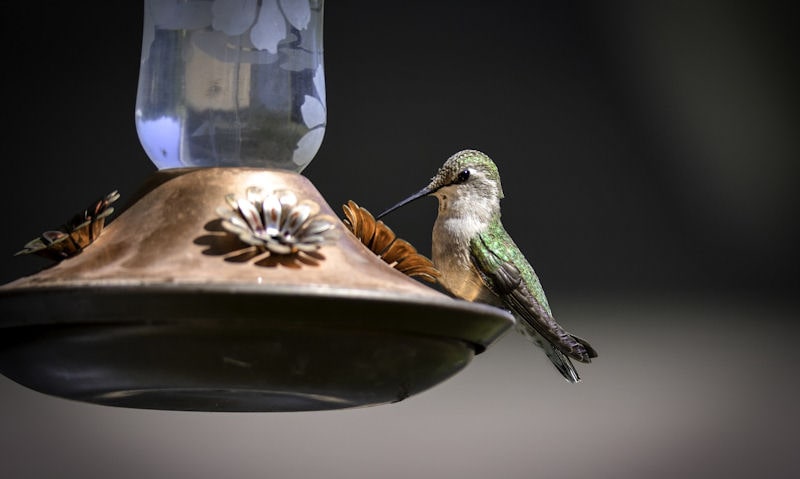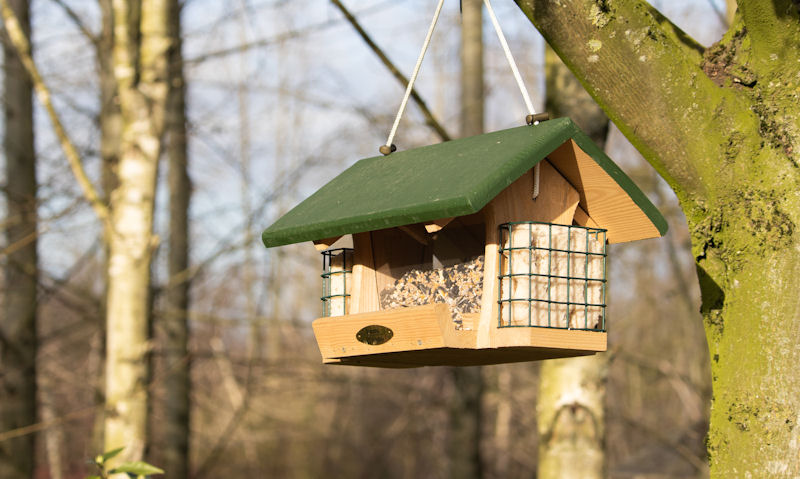How does a Finch feeder work
Finch feeders are essentially seed feeders, but are made to store thistle seeds, of which this seed must not be allowed to spill between the gaps in the wire or the port holes.
How does a Finch feeder work, which is a thistle feeder if you didn't know, would focus on restraining the fine thistle seed to prevent it spilling, as it would in a normal seed feeder. Clear tube feeders feature divided small port wells, with the wire mesh Finch feeders featuring tighter gaps.
Finch feeders are among the easiest type of bird feeders you can use, in terms of how they disassemble to clean, or open to replenish with fresh thistle seeds.
So you know, a Finch feeder is essentially a thistle bird feeder, with only the name of the species who use it most, which are American Goldfinches, added to the name.
How do Finch feeders work relies on how the thistle seeds are stored, and how your wild birds access this hard to access fine bird seeds. Finches have no trouble accessing the thistle seeds, which is where a spill tray can come in useful.
Best seeds to attract Finches are always going to be thistle, yet this small seed is difficult to dispense in a classic seed bird feeder.
Makers of these thistle/finch bird feeders must then provide a way to allow birds to pull out the seeds, yet avoid these difficult small seeds freely spilling out with no plug to stop wasted.
Answer to that is, making the access holes on a tube feeder really small, which will also lead to be divided up on a single port well hole. Similarly, the gaps between the wire on a mesh bird feeder are closely tight together.
Either the tube or wire Finch feeder will feature some yellow in color but it isn't needed, as the same bird feeders may have a copper effect.
Finch feeders will be suspended on a pole or tree branch via the long or short hanger, used to hang the feeder.
And while I don't go into the workings of a Finch sock, this feeder will operate similar to a tube or wire style Finch feeder; in how its dispenses thistle seeds to how its suspended, where it must be hung off a bird feeding pole or tree branch.
With three to types of Finch recommended bird feeders available on the market today - including a tube and wire mesh feeder, plus a thistle sock - all essentially provide a way for Finches to pull out these small seeds.
Small, restricting port holes in tube
One popular type of finch feeder you can buy - and will of course be a thistle only bird feeder - is the near identical seed feeder, only its developed specifically to hold thistle.
What is a clear plastic tubular seed bird feeder, this thistle feeder will be between a foot or two long. How this Finch feeders works is how it will depend on small, restricting access points on any available port holes.
Port holes on any tube seed feeder are where wild birds can feed off a perch usually mounted directly below the holes, where birds grab the thistle seeds.
Seeing as thistle seeds will simply spill out of the port wells on a general seed mix bird feeder - and know that these access points will restrict thistle spilling - and therefore will restrict the feeder to only small songbirds.
Small, restricting port hole numbers in a tube seed feeder will very, whereby thistle seeds can only be eaten when they are pulled out whole.
It isn't possible thistle seeds can spill out these tiny holes, unless the Finches, and Sparrows among others, literally pull out the seeds to eat their, or take it away.
With a clear plastic tube thistle bird feeder displaying the level of thistle available, there is also a fine wire mesh thistle bird feeder to consider.
Tight gaps in wire mesh
What is seen as a classic Finch bird feeder that isn't so much a clear plastic tube, but more a fine metal mesh cylinder shape feeder.
How this type of Finch feeder works is how many Finches, including American Goldfinches, can access it, like: Common Redpoll's, Lawrence's Goldfinches, Pine Siskin's, Lesser Goldfinches and Purple Finches to name a few - who can all access a thistle-filled bird feeder of this kind.
American Goldfinches being one of the most common backyard bird feeder birds, will be mostly attracted to what is a finished in black wire feeder.
With that, you can expect the same metal wire Finch feeders to feature a yellow lid/top or base, in an attempt to match an American Goldfinches plumage - and the color of the wild flowers they will visit in the wild.
Why you'll find the metal wire style Finch feeders featuring fine gaps between the wire, would be to prevent the fine thistle seeds freely spilling.
In fact, if the wire wasn't so tightly crossed you would expect to see the thistle spill out like sand through a sieve effect.
All metal wire Finch feeders like this will allow wild birds to cling around the cylinder, with no relying on strategically positioned port wells like you do on the tubular Finch feeders.
Easy to fill or disassemble
With Finches landing on the perch of a clear plastic tube like feeder, or indeed other birds clinging around the sides of a fine wire thistle feeder, know that both models are easy to replenish and clean.
In case of a clear plastic tubular style Finch feeder, you must remove any perches along with and the base, to fully remove this section of the feeder. In addition, the lid can be fully pulled off, or could it be a still attached lift off lid.
With all these parts separated from the clear plastic tube, the Finch feeder will be ready for a proper clean in dish soap, with an option to disinfect.
Now you know how to disassemble this type of finch/thistle feeder, you'll know then all it takes to re-fill a Finch feeder, is to simply lift off, or unscrew the lid.
In case of a Finch feeder that is made with a wire surround, only the lid and base keeps the structure in place, and therefore must be unscrewed or popped out like the clear tube-style feeder.
Sometimes a Philip screwdriver is needed to in fact remove the screws to disassemble this wire mesh thistle feeder.
How to replenish with fresh thistle seeds simply relies on the lid being pulled up, and put over to one side; as it usually remains attached to the bar, which is used to hang this heavier wire mesh thistle feeder.
Spill tray will assist Finches
Still on the subject of a wire mesh style Finch feeder - and this can apply to the more classic tube seed feeder type - is how you can buy a thistle feeder with a seed spill tray attached to the bottom.
How a Finch feeders works will rely on wild birds perching on a small, confined perch protruding out of the feeder, or the birds must awkwardly cling around the sides of what is a wire mesh feeder.
With most Finches fully capable of feeding out of small confined thistle seed feeders, other species who like thistle seeds, can find it difficult to cling or perch in a tight spot.
How to attract as many birds to a Finch feeder will depend on making it fully accessible, thus a seed spill tray attached to the base can assist all kinds of species, both large and small.
Spill trays will help Finches who don't wish to feed at an awkward angle, yet will allow Sparrows, Nuthatches to even Cardinals to eat on what was previously a difficult to access bird feeder.
With a spill tray featured, birds will use this dish as a seed tray and place to perch, yet the seeds available out in the elements will ensure more birds can eat.
Summarize
How does a Finch bird feeder work, will depend on the type in question. Finch feeders are essentially thistle seed feeders, and with that these bird feeders must be designed in such as way, this fine bird seed can't spill to the ground.
Essentially, a Finch feeder will be made with small, confined access points where thistle seeds will be pulled out by largely American Goldfinches.
Seeds of thistle are incredibly tiny, so if they were to be placed in a traditional mix seed feeder, you'll be left helpless as the thistle seeds spill to the ground like sand.
With that to deal with, manufacturer's reduce the port well hole size - which is the feeding holes where wild birds access the seeds - in such a way, they can't fall out of the feeder.
Finch feeders work in such a way the thistle seeds much be confined to a clear plastic tubular feeder, or if its the metal wire mesh thistle feeder, the thistle seeds will be stored behind tiny wire gaps.
With a tubular thistle seed feeder, several port holes will be made available along with a perch attached beneath it.
In case of a metal wire mesh thistle feeder, Finches are able to cling at all angles to pull out the fine thistle seeds between the metal wire gaps.
Easy to replenish and clean, Finch feeders depend on the user to disassemble the feeders base - on both the tube and wire mesh feeder - in order to make way for you to clean all the parts thoroughly.
How you fill a Finch feeder will simply rely on you popping off the lid, lifting up the lid still attached to the bar used to hang... or the lid can be unscrewed all the way.


